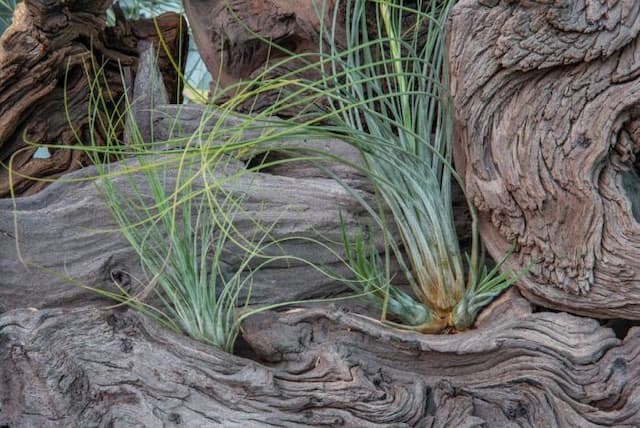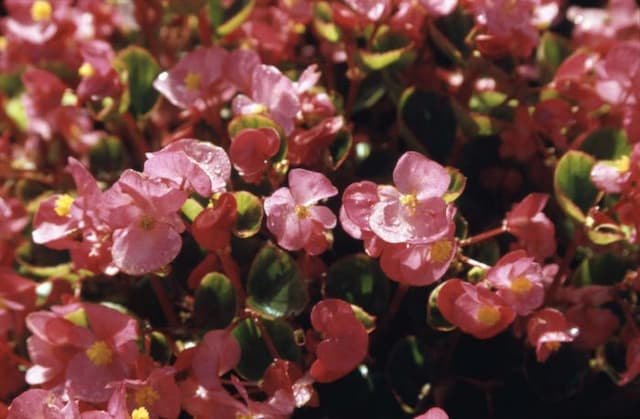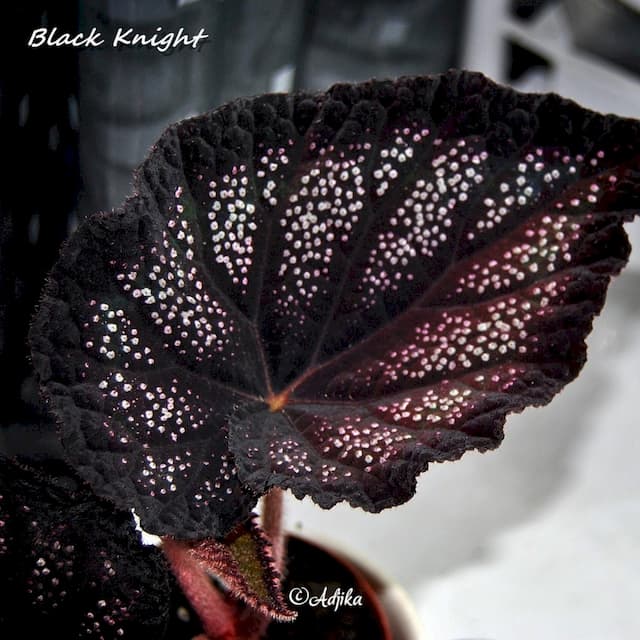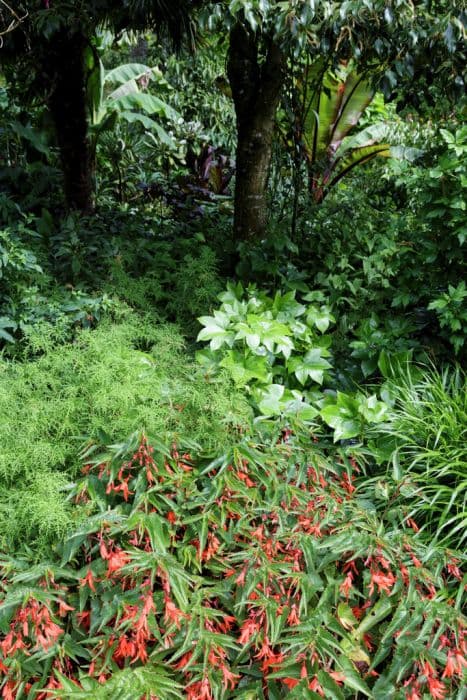Ziggy Begonia Begonia 'Ziggy' (T)

ABOUT
Begonia 'Ziggy' is a striking variety that stands out for its unique foliage and overall vibrant appearance. The leaves of this plant are the most eye-catching feature; they showcase a spiral pattern that makes them incredibly ornamental. Each leaf presents a mix of colors, typically green and silver with a metallic sheen that can catch the light beautifully. The green often takes on darker hues and may have reddish or purple undertones, while the silver traces intricate lines and patches, giving a stunning contrast. The texture of the leaves is another remarkable aspect. They are often slightly puckered or wavy, which adds depth and interest to the plant's profile. The spiral nature of the leaf growth can create a visual effect of movement, with the leaves seemingly twisting around themselves. Flowers of Begonia 'Ziggy' also contribute to its ornamental value, though they are not typically as showy as the foliage. The blooms may be small and delicate, commonly in subtle shades of pink or white, and they grow in clusters. These flowers can add a gentle touch of color amidst the boldness of the leaves. Overall, Begonia 'Ziggy' is lush and full, with its foliage taking center stage. It can be a lively addition to an indoor space or shaded garden area, bringing with it a distinctive flair and natural beauty. The combination of its spiral-patterned leaves, textured surface, and metallic sheen makes it a desirable choice for plant enthusiasts looking for a visually intriguing specimen.
About this plant
 Names
NamesFamily
Begoniaceae
Synonyms
Zig Zag Begonia, Star Begonia
Common names
Begonia 'Ziggy'
 Toxicity
ToxicityTo humans
Begonias, including Begonia 'Ziggy', contain insoluble oxalates which can be mildly toxic to humans if ingested. Symptoms of poisoning typically involve irritation of the mouth, lips, throat, and tongue. Ingestion can lead to difficulty swallowing, a burning sensation, and vomiting. The most common consequence of ingesting begonias is discomfort and pain in the oral cavity and gastrointestinal tract.
To pets
For pets, Begonia 'Ziggy' is also toxic due to the presence of insoluble oxalates. If a pet, such as a dog or cat, ingests parts of the plant, they could exhibit signs of poisoning which might include vomiting, drooling, and difficulty swallowing. Oral irritation, pawing at the mouth, and decreased appetite could occur. The primary consequence of ingestion is discomfort and pain in the mouth and gastrointestinal irritation.
 Characteristics
CharacteristicsLife cycle
Perennials
Foliage type
Evergreen
Color of leaves
Mixed
Flower color
Pink
Height
1-2 feet (30-60 cm)
Spread
1-2 feet (30-60 cm)
Plant type
Herb
Hardiness zones
10
Native area
Central and South America
Benefits
 General Benefits
General Benefits- Decorative Appeal: Adds vibrant color and unique patterns to indoor and outdoor spaces with its striking foliage.
- Low Maintenance: Requires minimal care beyond regular watering and occasional fertilizing, making it suitable for gardeners of all skill levels.
- Shade Tolerance: Thrives in areas that receive less sunlight, which is ideal for brightening up darker corners of a garden or home.
- Humidity Resistance: Adapts well to humid conditions, making it a good choice for bathrooms and kitchens.
- Compact Growth: Its manageable size allows it to fit well in small spaces or as part of a container garden.
- Versatility: Can be used in a variety of gardening designs, including hanging baskets, terrariums, and as a ground cover.
- Propagation Ease: Can be easily propagated from leaf cuttings, allowing gardeners to create new plants for free.
- Seasonal Interest: Some varieties offer seasonal blooms, adding an additional layer of interest to the foliage.
- Non-Toxicity: Safe for homes with pets and children, as it is not known to be toxic.
- Community Building: Popular among plant enthusiasts, allowing for easy swapping and sharing with other gardeners.
 Medical Properties
Medical PropertiesThis plant is not used for medical purposes.
 Air-purifying Qualities
Air-purifying QualitiesThis plant is not specifically known for air purifying qualities.
 Other Uses
Other Uses- Crafting Natural Dyes: Extracts from Begonia 'Ziggy' can be used to produce natural dyes for fabric, offering a range of hues dependent on processing techniques.
- Educational Tool: The unique patterns of Begonia 'Ziggy' make it ideal for botany lessons to illustrate genetic variation and plant hybridization concepts.
- Photography Subjects: The striking appearance of Begonia 'Ziggy' provides an excellent subject for photographers, especially those specializing in macro photography and plant portraiture.
- Art Inspiration: Artists may use the Begonia 'Ziggy' as inspiration for paintings, drawings, or textile designs due to its vibrant coloration and leaf patterns.
- Living Mulch: When planted densely, Begonia 'Ziggy' can act as a living mulch, suppressing weeds and helping retain soil moisture in garden beds.
- Leaf Castings: The textured leaves of Begonia 'Ziggy' can be used to make decorative leaf castings in plaster or cement for garden ornaments.
- Theme Gardens: Incorporate Begonia 'Ziggy' into special-themed gardens, such as a 'Funky Foliage' or 'Tropical Escape' garden, enhancing the aesthetic appeal.
- Floral Arrangements: Although primarily grown for its foliage, Begonia 'Ziggy' can also be included in floral arrangements as a striking and exotic green accent.
- Stress Reduction: Positioning Begonia 'Ziggy' in areas where people relax or meditate can create a tranquil, visually pleasing environment, facilitating stress reduction.
- Culinary Garnish: The non-toxic leaves of Begonia 'Ziggy' can be used as an ornamental garnish for culinary dishes, adding a splash of color and sophistication. (Do not consume without verifying safety)
Interesting Facts
 Feng Shui
Feng ShuiThe Begonia is not used in Feng Shui practice.
 Zodiac Sign Compitability
Zodiac Sign CompitabilityThe Begonia is not used in astrology practice.
 Plant Symbolism
Plant Symbolism- Caution: Begonias in general are known to symbolize caution or a warning to be careful, perhaps due to their delicate nature and the need to take care when handling them.
- Individuality: Their unique patterns and vibrant colors can represent individuality, celebrating uniqueness and personal expression.
- Harmony: The balanced and symmetrical growth of some Begonia varieties can symbolize harmony and balance in one's life.
- Gratitude: Giving Begonias as a gift is often associated with feelings of deep appreciation and thankfulness towards the recipient.
 Water
WaterBegonias should be watered thoroughly when the top inch of the soil feels dry to the touch. For Ziggy Begonia specifically, you may find that this occurs approximately once a week, but frequency can vary depending on the environment. Use lukewarm water to avoid shocking the plant. When you water, aim to use around 16 ounces for smaller pots or up to half a gallon for larger pots, ensuring that the water runs freely from the drainage holes at the bottom. It's important to avoid overwatering, as Begonias are susceptible to root rot.
 Light
LightZiggy Begonia thrives in bright, indirect light. Avoid placing it in direct sunlight as this can scorch the leaves. A spot near an east or west-facing window where it can receive gentle morning or afternoon sun, filtered through a sheer curtain, is ideal. If the natural light is limited, you can supplement with a grow light.
 Temperature
TemperatureZiggy Begonia prefers temperatures between 65°F and 75°F during the day and no lower than 60°F at night. The plant can handle temperatures up to around 85°F but will start to suffer if it goes any higher. It's important to keep them away from drafts and drastic temperature changes, which can cause stress.
 Pruning
PruningRegularly prune your Ziggy Begonia to remove any dead or yellowing leaves to encourage healthy growth and improve air circulation. The best time for pruning is in the spring or early summer when the plant is actively growing. Prune lightly, up to once per month, to maintain the desired shape and promote bushier growth.
 Cleaning
CleaningAs needed
 Soil
SoilThe best soil mix for Begonia 'Ziggy' should be light and well-draining, consisting of peat moss, perlite, and pine bark fines in equal parts. Aim to maintain a soil pH between 5.5 and 6.5 for optimal growth.
 Repotting
RepottingBegonia 'Ziggy' should be repotted every 1-2 years or when it becomes root-bound. This will provide fresh nutrients and encourage continued healthy growth.
 Humidity & Misting
Humidity & MistingBegonia 'Ziggy' thrives in high humidity levels, around 50 to 70%. Avoid placing it in excessively dry environments to maintain its vibrant foliage.
 Suitable locations
Suitable locationsIndoor
Provide bright, indirect light and high humidity.
Outdoor
Shelter from direct sun, keep in warm, humid conditions.
Hardiness zone
10-11 USDA
 Life cycle
Life cycleThe life cycle of Begonia 'Ziggy' begins with seed germination, where the seeds sprout in warm, moist soil conditions, typically within a greenhouse or controlled environment. Following germination, the seedlings develop into juvenile plants with characteristic asymmetrical leaves and may start showing their mottled green and silver foliage. As it enters into the vegetative stage, the plant undergoes robust leaf growth and forms a bushy, compact shape due to its fibrous root system. Begonia 'Ziggy' then reaches maturity where it can produce blooms, displaying its unique pink to white flowers, although flowering may not be as prominent or the main attraction of this ornamental variety. It continues to grow and can be propagated by cuttings or division, allowing the life cycle to begin anew with a genetically identical plant. In most climates, Begonia 'Ziggy' is treated as an annual or brought indoors during colder months, but when provided with the right conditions, it can live for several years, making it a perennial in some cases.
 Propogation
PropogationPropogation time
Spring-Early Summer
The Begonia 'Ziggy' can be propagated most successfully by leaf cuttings, a method widely appreciated for its simplicity and effectiveness. To propagate 'Ziggy' Begonias from a leaf cutting, choose a healthy, mature leaf and cut a piece, ensuring you include a bit of the petiole. Submerge the cut end of the petiole in a rooting hormone to encourage growth and plant it in a pot filled with a well-draining soil mixture. You should moisten the soil, but be sure not to oversaturate it, as Begonias are prone to rot in excessively wet conditions. After planting the cutting, provide it with bright, indirect light while maintaining consistent humidity around the cutting to promote root development. Within a few weeks, the leaf will start to root and eventually sprout new growth, signaling the successful propagation of the new 'Ziggy' Begonia.

![Begonia [Allure]](/_next/image?url=https%3A%2F%2Fplants-admin.emdemapps.com%2Fimages%2Fplants%2F%2Fimages%2F604b5b9006ab9.png&w=640&q=75)







